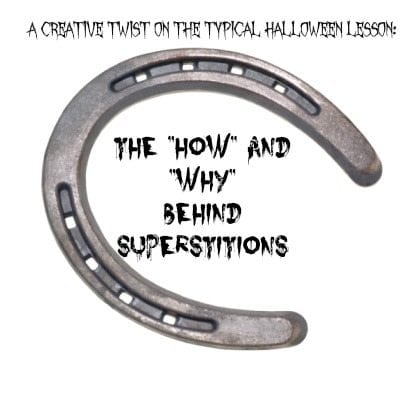 guest post by Joann Wasik from The Gateway.org
guest post by Joann Wasik from The Gateway.org
It’s mid-October, which means that little ghosts and goblins everywhere are gearing up for a fun, sugar-fueled night of trick-or-treating on Halloween. The kids’ growing excitement is palpable, and teachers often tap into their students’ interest by offering Halloween-related crafts and projects. Students of all ages respond well to ghost stories and Gothic fiction lessons, with many middle and high school classes delving into spooky classics such as Mary Shelley’s Frankenstein or Washington Irving’s The Legend of Sleepy Hollow. Still looking for something different? How about exploring the “how” and “why” behind superstitions?
The word “superstition” carries a rather negative connotation, as it refers to a belief that is not based on reason, but is, in fact, irrational. Still, superstitions are deeply rooted in human history, and persist in the 21st century. Your students can likely cite a litany of common superstitions: Break a mirror? Seven years’ bad luck! Black cats are unlucky, and don’t even think about opening an umbrella indoors. While the number 13 is considered unlucky in western cultures, many Asian cultures avoid the number four whenever possible, as its pronunciation can be the same as for the word “death”. While most people probably don’t actually believe in such superstitions, evidence of superstitions’ influence still pervades our lives on a daily basis. Most hotels, office, and apartment buildings still don’t have a 13th floor; the 14th floor immediately follows the 12th floor. Despite medical evidence to the contrary, some parents are still convinced that swimming immediately after eating will induce cramps. We still knock on wood to keep our good luck flowing, hunt for four-leaf clovers, await a groundhog’s shadow to forecast the end of winter, and make wishes on fallen eyelashes. Esteemed medical journals, too, have examined the role of superstition in daily life: A 1993 British study, for example, found a definite correlation between Friday the 13th and increased traffic accidents, where doctors saw a 52% increase in hospitalizations due to traffic accidents on Friday the 13th versus other Fridays. The doctors’ recommendations? Stay home on Friday the 13th.
This week I’ve highlighted three resources on superstitions from the Gateway’s collection. I’ll also be featuring many more lessons, resources, and activities throughout the week on our Twitter and Facebook pages – many of them for ELL students as well. Please read my colleague Peggy’s companion column (linked below) for additional resources and teaching ideas that take advantage of the spooky season.
List of Superstitions Lesson Plan
Subjects: Writing, Social studies
Grade: 3-5
Why do we believe in the prognostication powers of a groundhog to tell us if when winter will end? This lesson plan asks students to pick from a list of superstitions, consider where the superstition came from, and then confirm their hypothesis with research. I like that this lesson asks students to try to track down the origins of various superstitions as well as make educated guesses as to why such superstitions were created in the first place. Great lesson for honing those critical thinking skills! This lesson is offered by Flocabulary, an online learning platform that delivers educational hip-hop songs and videos to K-12 students.
Superstitions and Old Wives Tales Lesson Plan
Subjects: Science, Language Arts, ESL
Grade: 7-9
In this lesson, students work in small groups to develop a hypothesis and conduct the steps of the scientific method by identifying and examining superstitions and old wives’ tales. I like how this lesson takes a scientific approach to explore a subject that is based largely on folklore and unsubstantiated beliefs – a good exercise in viewing a subject from different viewpoints. This lesson, written by a teacher, is available through Seach-Document.com.
The Role of Superstition in The Adventures of Huckleberry Finn
Subjects: English Language Arts
Grade: 9-12
How does superstition have a bearing on the novel The Adventures of Huckleberry Finn? Can students use the novel to investigate their own superstitions? I like how this lesson not only exercises students’ literary analysis skills, but also has them make connections between Huck’s beliefs and fears and their own. This lesson was produced by Linda Dursteler at Weber University.
